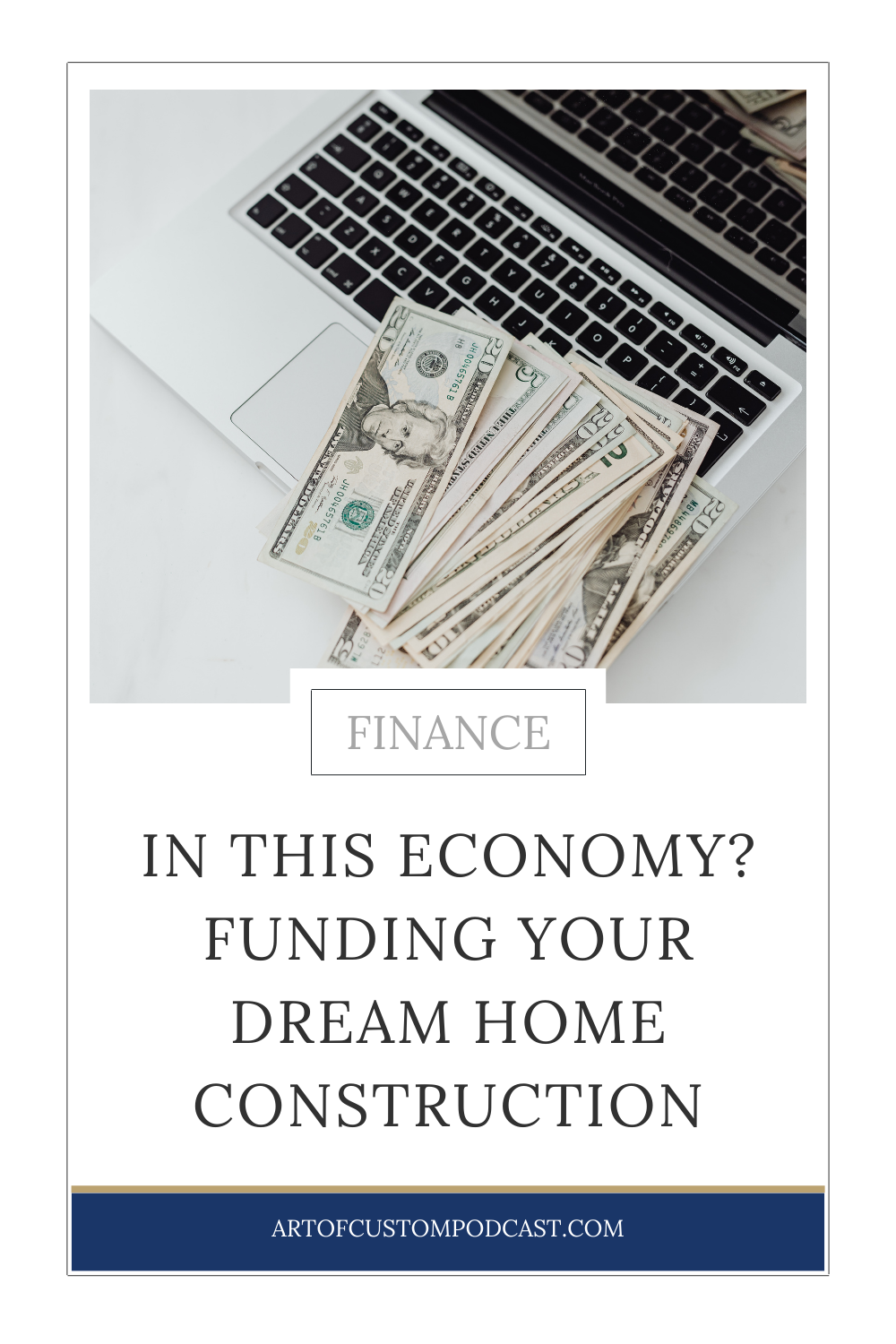In This Economy? Funding Your Dream Home Construction
Figuring out how you will fund your construction project and securing the right piece of land to build on are critical first steps in the process of building your dream home. However, the steps can feel a little murky, especially if this is your first time building a home.
Add to the confusion the recent headlines about interest rate increases, and you may be thinking your dream home vision is further away than you thought.
Before you put your construction plans on hold, Trisha McConkey from Associated Bank (four time guest and friend of the show) is here to help you figure out how to start building your home today and spend less than you would if you waited.
You can read the transcript below, or...
Episode Tool Box:
DOWNLOAD: Guide to Construction Lending

SEASON SIX, EPISODE THREE | TRANSCRIPT
Interest Rates & Market Psychology
Even with higher interest rates, it can still be a smart time to build. Rates at the time of recording were historically lower than many past decades, and materials and labor costs aren’t expected to drop. Waiting for a better time can actually mean paying more later.
Each time the Federal Reserve adjusts rates, the market briefly pauses and then quickly rebounds as buyers realize they can always refinance later when rates fall. It is always better to focus less on temporary rates and more on long-term financial strategy and personal readiness.
Inflation, Demand & Housing Inventory
Construction costs tend to rise due to strong demand and limited housing inventory and it can impact your building schedule and pricing when you decide to wait. Many people who delayed building during the pandemic turned around to find that both home prices and interest rates increased, putting their build out of reach.
In 2022, the U.S. is still recovering from the 2008 housing crash, a time when many builders and trades left the industry. Today, there simply aren’t enough new or existing homes to meet demand and that is especially true for custom builds.
The takeaway: don’t wait for prices to drop. Instead, adjust your plans, evaluate your priorities, and build strategically for the future.
Value Engineering: Build Smart Within Budget
Value engineering is a collaborative process between the homeowner and builder that brings costs in line with budget without compromising goals.
In a nutshell, here’s how value engineering works:
- You design your dream home.
- Your builder prices it out.
- If the estimate is higher than expected, you revisit design complexity and finishes to find savings that do not impact quality or style.
Adjusting selections such as swapping high-end built-ins or specialty tile for more cost-effective options can preserve overall quality and design integrity without sacrificing your goals.
The Importance of Choosing the Right Lender
Building a custom home requires a lender who understands in construction financing, not just traditional mortgages. Construction loans are complex: they combine land, design, and build costs into one loan with phased disbursements.
Key reasons to choose a construction-experienced lender:
- They understand how draws and inspections work.
- They know how to structure payments to keep work moving smoothly.
- They anticipate issues like appraisals, contingencies, and lien waivers.
- They act as true partners and help you navigate every step, not just closing day.
It is important to work with a local, accessible loan officer instead of an anonymous 1-800 number. A good lender stays involved from groundbreaking through move-in.
Understanding Construction Contingencies
Every project needs a contingency fund set aside to cover surprises or upgrades that come along during home construction.
Why contingencies matter:
- They cover unknowns, like rock or clay discovered during excavation.
- They allow flexibility for mid-build design changes like adding outlets or upgrading finishes.
- They protect you from out-of-pocket expenses if prices fluctuate during construction.
Reputable lenders and builders don’t view contingencies as extra spending. They are truly safety nets for the homeowner. If unused, they simply stay in the bank. During construction, borrowers make interest-only payments on drawn funds, so unused contingencies don’t cost anything unless spent.
Loan Types: One-Time Close & Adjustable Options
Construction lending has evolved, and one-time close loans are now standard for most lenders.
Here’s how they work:
- You close once, before construction begins.
- The loan covers both the build and permanent mortgage.
- Once construction ends, it automatically converts to a long-term mortgage—no second closing, no extra fees.
For example, Trisha explains that Associated Bank offers both fixed-rate and adjustable-rate (ARM) options. Adjustable loans provide security during construction, then flexibility to refinance or convert once rates drop.
Portfolio vs. Secondary Lenders
Associated Bank is a portfolio lender, meaning it holds and services its own loans instead of selling them to other institutions. This allows greater flexibility with down payments, loan terms, and conversion options.
By contrast, secondary lenders sell loans on the open market, which can limit flexibility and subject clients to changing servicers. Portfolio lenders can tailor loans to each client’s project, offering a smoother, more personalized experience.
Down Payments & Lot Equity
Down payments typically range from 10–20%, depending on credit, property type, and lender policies. If you already own your land, its appraised value counts toward your equity, potentially reducing the required cash down.
Other factors affecting down payments:
- Credit score and debt-to-income ratio.
- Whether the home will be a primary residence or secondary property.
- Lender type and regional lending practices.
Appraisals: The Make-or-Break Step
Appraisals are critical for construction loans because they determine loan-to-value ratios and overall financing eligibility.
Ask potential lenders these key questions about their appraisal process:
- Do they use appraisers experienced in new construction?
- How are appraisers selected and assigned?
- What happens if an appraisal comes in low?
- Will they allow reappraisal before or after construction?
At Associated Bank, a specialty panel of appraisers is used for construction projects to ensure they understand reading construction documents and the correct way to value custom features. This helps prevent undervaluation, especially for high-end or energy-efficient homes.
Lending for High-Performance Homes
As high-performance and energy-efficient homes become more popular, lenders are beginning to recognize their long-term value.
Lenders may allow a higher debt-to-income ratio for energy-efficient homes because lower utility bills offset monthly expenses. Some appraisers use green appraisal addendums that document sustainability features and help capture their added value in the home’s assessed worth.
Final Advice: Build the Team Early
The biggest takeaway? Assemble your dream team before you start building. That means:
- Selecting your builder, architect, and lender upfront.
- Setting a realistic budget based on both design goals and financial strategy.
- Using your lender’s pre-approval and budget analysis to guide your design decisions.
When your entire team works together from the start, you’ll enjoy a smoother, less stressful building process, and a stronger financial foundation.
For more information, visit www.artofcustompodcast.com. Or find us on Facebook and Linkedin as The Art of Custom. Be sure to subscribe to get the latest episodes and please rate and review. The Art of Custom is produced by Hug Monster Sound with original music by Adam Frick-Verdine. Thanks for listening.

